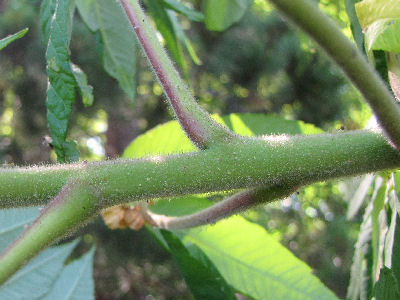
It's the time of year when many of the sumac trees begin to blossom. There are five kinds of sumac (Genus Rhus) that can be found in Michigan. I have three of them in "my kingdom." All of them are small trees or shrubs. The two I don't have are an aromatic shrub, and the poison sumac. Poison sumac only grows in specialized locations, certain kinds of swamps. None of the others is poisonous.
In the picture above, you can see the flowers of Smooth Sumac, Rhus glabra. Glabra is a good word to know if you want to play at a little botany. It just means "smooth," and many plants are described as glabrous. So if you see that word it means that the plant is not hairy or fuzzy or sticky or anything other than smooth.
The Smooth Sumac, therefore, has smooth twigs and the flower clusters are creamy colored and triangular, like little Christmas trees.

The other really common sumac is Staghorn Sumac, Rhus typhina. You can see that the flower clusters are much tighter. And they turn bright red! Here, they are just beginning to turn red, although they start out creamy, like the Smooth Sumac. The tight, red clusters remain on the trees for the entire next year.

Staghorn Sumac is anything but smooth! The twigs are covered with fine, dense fur, which is also slightly sticky. It got its common name because the twigs are reminiscent of the velvet on a stag's horns when they are growing in each year.

The other one that I have here is nifty. It is Shining or Winged or Dwarf Sumac, Rhus Copallina. The leaves are very shiny, and as you can see, they grow right down along the stem, making it look winged, and it is usually under 10 feet tall. Copallina means sticky or resinous, and its stems are also sticky to the touch. You may be familiar with the word "copal" which is a kind of resin used in varnishes. That word comes from the same origin.
All of the sumacs turn bright red in the fall, and can be very pretty. I'll hope to show you pictures again in that season.
8 comments:
thanks for introducing us to sumac and its varieties, will look forward to the fall.
PS...sorry, i still am not able to do the tag game, hard to think of the 6 to share :) but once i do it, will let you know.
I now know what that is growing on my bank - Staghorn Sumac. I learn something every time I visit - Thanks!
Cool plants I never get to see. Thanks for botanining Michigan style!
Hi Betchai- I will try to get some good pics in the fall. It's really a spectacular red. Don't worry about the game... they aren't fun if you feel forced!
Rebecca- I'm SO tickled that this information was interesting and helpful. Lots of times I find this stuff more interesting than almost anyone else.
Julia- really? there are no sumac in California? That's weird.
I was just looking at sumac yesterday. I like taking pictures of those red clusters.
Hi Ratty- I like the red fruits best too!
That's for a trip back to my days at Pioneer Girls Camp. I think Sumac was the first plant I learned to identify in Nature Trail class. A fun reminder of days when living outdoors was the "norm."
Before anyone goes looking for these because they are pretty....they are insidious. They will literally take over your yard. They are a very, very, VERY invasive plant and almost impossible to get rid of once you have them. Trust me.. I try. lol.
Post a Comment